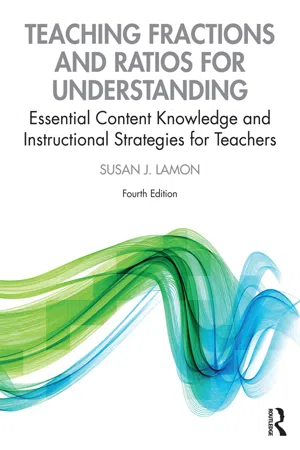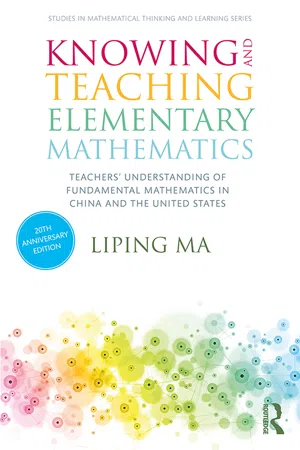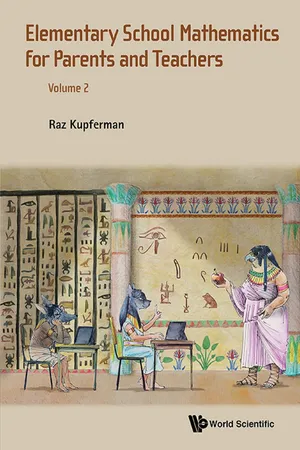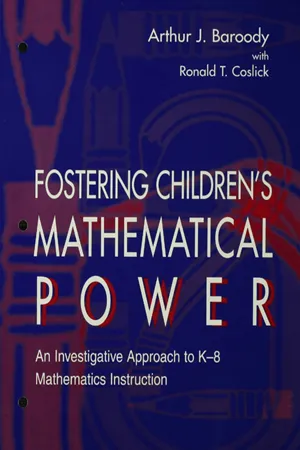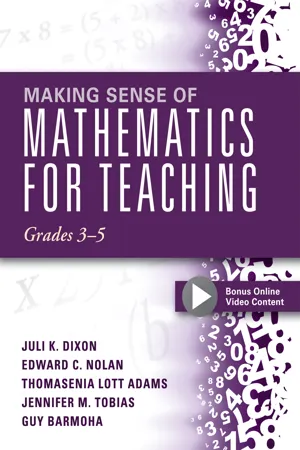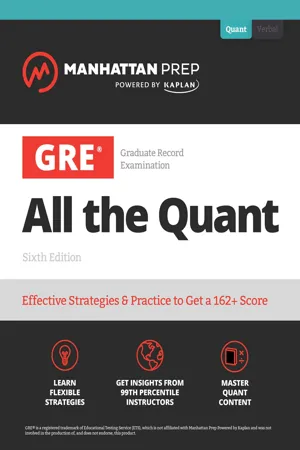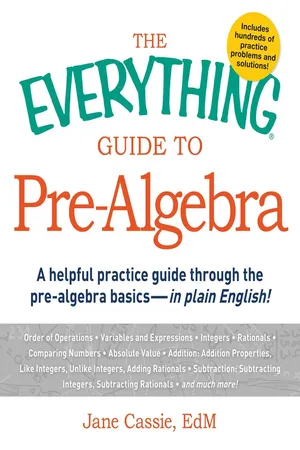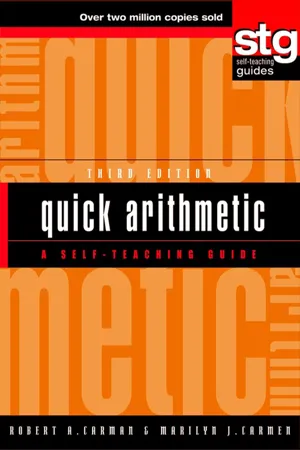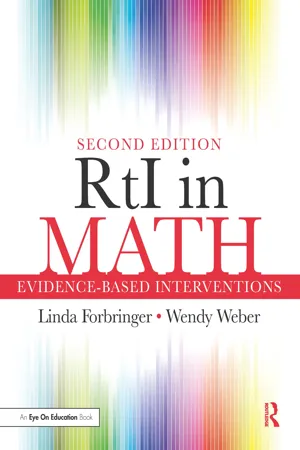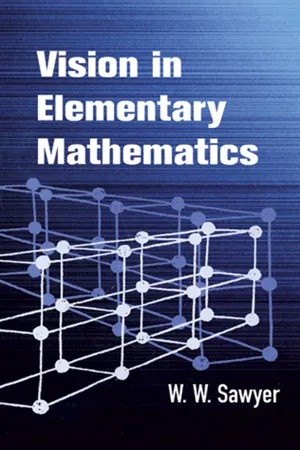Mathematics
Multiplication and Division of Fractions
Multiplication of fractions involves multiplying the numerators together to get the new numerator and multiplying the denominators together to get the new denominator. Division of fractions is done by multiplying the first fraction by the reciprocal of the second fraction. In both operations, it's important to simplify the fractions by canceling out common factors.
Written by Perlego with AI-assistance
Related key terms
11 Key excerpts on "Multiplication and Division of Fractions"
- eBook - ePub
Teaching Fractions and Ratios for Understanding
Essential Content Knowledge and Instructional Strategies for Teachers
- Susan J. Lamon(Author)
- 2020(Publication Date)
- Routledge(Publisher)
When children worked with whole numbers, they operated on them principally by adding and subtracting. They began to develop some meaning for the operations of multiplication and division, but only in carefully chosen contexts using carefully chosen numbers and labels. Before the introduction of fractions, children develop only a very limited understanding of multiplication and division. This is because true understanding of the operations of multiplication and division can only come about when a student is able to construct composite units or units composed of multiple entities, and fraction notation is needed to help represent the complex quantities that result from multiplication and division.When working with whole numbers, quantities had simple labels that came about by counting or measuring: 5 candies or 7 feet. The operations of multiplication and division often produce new quantities that are relationships between two other quantities. Furthermore, the label attached to the new quantity (the relationship) is not the label of either of the original quantities that entered into the relationship.24 candies divided among 6 party bags isWe have a new quantity that is not measured by one of the original measures, candies or bags .or24 candies6 bags.6 candies1 bagAlso, whole number quantities could be physically represented. Students could draw a picture of candies or they could use beans or blocks or chips to represent things being counted. However, a quantity expressing a relationship such as 2.5 children per family or 12 miles per hour (mph) cannot be easily represented or conceptualized.To further complicate the labeling issue, sometimes a quantity that is really a relationship between two quantities is given a single name. For example, consider the relationship between a certain distance traveled and the time it took to travel that distance. That relationship is so familiar that we chunk the two quantities into a single entity and refer to it as speed . When we refer to speed or to other chunked - eBook - ePub
Knowing and Teaching Elementary Mathematics
Teachers' Understanding of Fundamental Mathematics in China and the United States
- Liping Ma(Author)
- 2020(Publication Date)
- Routledge(Publisher)
These teachers regarded the relationship between multiplication and division in a more abstract way. They ignored the particular meaning of the multiplicand and multiplier in multiplication and related models of division. Rather, they perceived the multiplicand and multiplier as two factors with the same status. Their perspective, indeed, was legitimized by the commutative property of multiplication.The concept of fractions as well as the operations with fractions taught in China and the U.S. seem different. U.S. teachers tend to deal with “real” and “concrete” wholes (usually circular or rectangular shapes) and their fractions. Although Chinese teachers also use these shapes when they introduce the concept of a fraction, when they teach operations with fractions they tend to use “abstract” and “invisible” wholes (e.g., the length of a particular stretch of road, the length of time it takes to complete a task, the number of pages in a book).Meaning of Multiplication by a Fraction: The Important Piece in the Knowledge Package
Through discussion of the meaning of division by fractions, the teachers mentioned several concepts that they considered as pieces of the knowledge package related to the topic: the meaning of whole number multiplication, the concept of division as the inverse of multiplication, models of whole number division, the meaning of multiplication with fractions, the concept of a fraction, the concept of a unit, etc. Figure 3.2 gives an outline of the relationships among these items.Figure 3.2 A knowledge package for understanding the meaning of division by fractions.The learning of mathematical concepts is not a unidirectional journey. Even though the concept of division by fractions is logically built on the previous learning of various concepts, it, in turn, plays a role in reinforcing and deepening that previous learning. For example, work on the meaning of division by fractions will intensify previous concepts of rational number multiplication. Similarly, by developing rational number versions of the two division models, one’s original understanding of the two whole number models will become more comprehensive: - eBook - ePub
- Raz Kupferman(Author)
- 2017(Publication Date)
- WSPC(Publisher)
Products of natural numbers can always be interpreted as repeated addition. Products of fractions, however, require a different interpretation. Thus, the multiplication concept must be extended and generalized in order to make sense of fraction multiplication. The main focus of this chapter is acquiring a unified image of multiplication, applicable to both natural numbers and fractions, and extending the scope of problems modeled by multiplication. Evaluation strategies are then derived based on our ability to correctly interpret products of fractions.Hurdles:(a)Children don’t understand the meaning of fraction multiplication and are content with knowing how to evaluate products.(b)Children are confused by the verbal interpretation of the multiplication sign as times in the context of whole numbers and of in the context of fractions.(c)Children have a misconception whereby multiplication is always a magnifying operation.Remedies:(a)Explain the meaning of multiplication as a scaling operation; this interpretation is sensible for both whole numbers and for fractions. (b)Practice fraction multiplication in the context of concrete word problems. (c)Use visual aids to demonstrate fraction multiplication. (d)Emphasize the relation between products of whole numbers, products of fractions and whole numbers and products of fractions. (e)Use concrete models to demonstrate why multiplication by a fraction is not magnifying, but rather reducing.31.1Numbers and multiplication revisited
The number concept was first introduced in this book in Chapter 1, and was further elaborated in subsequent chapters. Notably, fractions were introduced in Chapter 27, extending the number system, which at first consisted only of natural numbers.Multiplication was first introduced in Chapter 7, building upon the notion of repeated addition. We encountered various settings in which multiplication models concrete problems, such as counting combinations and measuring area. In the context of fractions, products of natural numbers and a unit fractions were used to define general fractions. That is, the fraction is defined as a repeated addition, m times, of the unit fraction - eBook - ePub
Fostering Children's Mathematical Power
An Investigative Approach To K-8 Mathematics Instruction
- Arthur Baroody, Arthur J. Baroody, Jesse L.M. Wilkins, Ronald T. Coslick(Authors)
- 1998(Publication Date)
- Routledge(Publisher)
, children must discover that the denominator of the sum is derived from multiplying the denominators of the addends, not adding them.In Unit 10•1, we illustrate how learning a variety of meanings for an arithmetic operation (see chapter 5 ) is crucial for comprehending operations on fractions, in general, and fraction multiplication and division, in particular. In Unit 10•2, we illustrate how to help children understand operations on common fractions. This understanding will make their task of understanding operations on decimals (addressed in chapter 11 ) considerably easier.What the NCTMStandards SayGrades K-4 “In grades K-4, the mathematics curriculum should include fractions so that students can:◆ use models to explore operations on fractions … ;◆ apply fractions … to problem situations” (NCTM, 1989, p. 57).Grades 5–8 “In grades 5–8, [instruction] should develop the concepts underlying computation and estimation in various contexts so that students can:◆ compute with…fractions…and rational numbers;◆ develop, analyze, and explain procedures for computation and .. . estimation;◆ use computation [and] estimation [procedures] to solve problems;◆ use estimation to check the reasonableness of results” (NCTM, 1989, p. 94).10•1 Mathematics and LearningIn Subunit 10•1•1, we outline meaningful analogies for operations on fractions. In Subunit 10•1•2, we explore children’s thinking for clues about where to begin instruction on fraction arithmetic and why it is often so onerous (see Figure 10.1 - eBook - ePub
Making Sense of Mathematics for Teaching, Grades 3-5
(Learn and Teach Concepts and Operations with Depth: How Mathematics Progresses Within and Across Grades)
- Juli K. Dixon, Edward C. Nolan(Authors)
- 2016(Publication Date)
- Solution Tree Press(Publisher)
You used an equation to represent the solution but not to determine the solution. Using an equation to solve typically means applying an algorithm—in this case, the algorithm of multiplying numerators and multiplying denominators to find the product of two fractions. Regardless of solution process, it is important to use estimation to check to see if the product is reasonable. For example, in the first word problem in figure 4.1, an answer of 3 ⁄ 6, or ½, is reasonable because ¾ × ⅔ can be thought of as ¾ of a group of ⅔ of a whole, so it is less than a whole group of ⅔ but more than half of a group of ⅔. Therefore, a reasonable product would be between ⅓ and ⅔. Finally, fifth-grade students are introduced to fraction division but only with two specific structures. Students divide: 1. Whole numbers by unit fractions (a unit fraction is a fraction with a numerator of 1), such as with 6 ÷ ⅓ 2. Unit fractions by nonzero whole numbers (they cannot divide by 0 as this quotient is indeterminate), such as with ¼ ÷ 2 Students encounter these structures with and without context and solve the problems using visual models or equations. Solving problems like these using equations provides an excellent opportunity to begin to make sense of the “invert and multiply” algorithm for dividing fractions. This algorithm is further developed in grade 6. Grade 6 In grade 6, students extend the work they began in grade 5 to divide fractions by fractions with and without context using visual models or equations. Students connect their previous experiences to make sense of the “invert and multiply” algorithm. They might even explore the common denominator algorithm for dividing fractions. In any case, they use estimation and their understanding of division to check the reasonableness of their results. Throughout the progression, emphasis is on reasoning and sense making. Much of what students encounter is presented in context, through word problems - eBook - ePub
GRE All the Quant
Effective Strategies & Practice from 99th Percentile Instructors
- (Author)
- 2023(Publication Date)
- Manhattan Prep(Publisher)
As discussed in Chapter 4: Equations, multiplication and division are opposite sides of the same coin. Any multiplication problem can be expressed as a division problem, and vice versa. While the mechanics for multiplication are straightforward, the mechanics for division are more complicated, so it’s better to express every fraction division problem as a fraction multiplication problem instead.How do you rephrase a division problem so that it becomes a multiplication problem? The key is reciprocals.Reciprocals are numbers that, when multiplied together, equal 1. For instance, and are reciprocals:The numbers 2 and are also reciprocals:To find the reciprocal of a number, take the numerator and denominator and switch them around: How are reciprocals used in fraction division? Start with this example:
All three rows of the table show the same math, but written in three different ways. Check it out:Integer division: 6 ÷ 2 = 3 Same problem, but in fraction form: Same problem as multiplication: To change from division to multiplication, do two things. First, take the divisor (the number to the right of the division sign—in other words, what you are dividing by) and replace it with its reciprocal. In this problem, 2 is the divisor, and is the reciprocal of 2. Then, change the division sign to a multiplication sign. So 6 ÷ 2 becomes . Finally, do the multiplication:This math is obviously overkill for 6 ÷ 2, but try this one:What is ?To divide by , multiply by its reciprocal, :Note that the fraction bar (sometimes indicated with a slash) is another way to express division: . If you see a “double-decker” fraction, don’t worry. It’s just one fraction divided by another fraction.To recap:Fraction Rule 4:To divide by a fraction, multiply by its reciprocal. - When you are confronted with a division problem involving fractions, rewrite it as a multiplication problem.
- A number multiplied by its reciprocal equals 1.
- To find the reciprocal of an integer, write 1 over that integer. To find the reciprocal of a fraction, switch the numerator and denominator:
- Catherine Sophian(Author)
- 2017(Publication Date)
- Routledge(Publisher)
Thus, for example, within the part–whole subconstruct, the denominator represents the number of parts into which the original unit is partitioned, and the numerator represents the number of those parts corresponding to the quantity being represented. The magnitude of the fraction decreases as the denominator gets larger, because the size of each part is decreasing, and the size increases as the numerator gets larger because more parts of that size are being included. Within the quotient interpretation, similarly, the numerator represents the dividend and the denominator the divisor of a division operation. The quotient decreases as the divisor increases and increases as the numerator decreases. The operator interpretation directly represents these inverse effects of numerator and denominator in terms of extending or stretching, on one hand, and contracting or shrinking, on the other.Thompson and Saldanha’s (2003) characterization of fractions in terms of the conception of two quantities as being in a “reciprocal relation of relative size” likewise underscores the conceptual coherence of fraction subconstructs. Their perspective, like the one advanced here, begins with the notion that fractions are fundamentally representations of magnitude. In addition, in recognizing that in order for one amount to be1 nthe size of another, the latter amount must be n times the size of the former, they emphasize the close link between fraction knowledge and multiplicative reasoning about many-to-one relations.THE INFORMATION-PROCESSING DEMANDS OF FRACTIONS
A number of accounts of fraction learning have called attention to the complexity of the information processing entailed in reasoning about fractions. Ohlsson (1991), for instance, argued that the concept of equivalent fractions is central to fraction arithmetic, and that it in turn entails a “schema of constancy under multiplicative compensation” (p. 39), that is, an appreciation of the fact that the inequality between the numerators of two equivalent fractions is offset by a proportionally equivalent inequality in the denominators. Kamii and Clark (1995) also emphasize the importance of multiplicative thinking in understanding fractions, but for them multiplicative thinking is closely related to the idea of one-to-many correspondence. It entails a hierarchical cognitive structure such that each individual item at one level corresponds to a group of items at the next lower level. Thus, for example, understanding the equivalence between1 4and3 12- eBook - ePub
The Everything Guide to Pre-Algebra
A Helpful Practice Guide Through the Pre-Algebra Basics - in Plain English!
- Jane Cassie(Author)
- 2013(Publication Date)
- Everything(Publisher)
not require a common denominator.When mathematicians talk about multiplication, they almost always use the word by . They say things like “multiply 2 by 5” or “When 2 is multiplied by 5, the product is 10.” But you can also think about multiplication in terms of how many of something you have. When you want to talk about the expression , you could just as easily say that you want to find two groups of three. So, when you multiply some number by 2, you’re finding two of that number. When you multiply something by 10, you’re finding ten of that number. When you multiply something by 1, you’re finding one of that number, which is why the final value isn’t altered at all when something is multiplied by 1.Multiplying Fractions
You can think of multiplying by a fraction in the same way. When you multiply any number by , you’re finding half of that number. You know that of 4 is 2, or of 100 is 25. That of is exactly the same as saying “multiplied by.” So you can think of these equations as “ multiplied by 4 is 2” or “ multiplied by 100 is 25.” When you multiply a positive number by a proper fraction, you’re actually taking a fraction of that number, and thus making it smaller.When you multiply a fraction by an integer, it helps to make both numbers into fractions. You do this, of course, by putting the integer over the number 1. So let’s say you’re asked to find:of 80You know that finding a fraction of a number is the same as multiplying the fraction by that number, so you can rewrite the expression as: Now that you’re multiplying a fraction by an integer, you want both numbers in fraction form. To turn an integer into a fraction, put a 1 in the denominator: What’s the rule for multiplying fractions? Multiply the numerators to get your new numerator. Multiply the denominators to get your new denominator. - eBook - ePub
Quick Arithmetic
A Self-Teaching Guide
- Robert A. Carman, Marilyn J. Carman(Authors)
- 2002(Publication Date)
- Trade Paper Press(Publisher)
We have converted a division problem that is difficult to picture into a simple multiplication. The final, and very important, step in every division is checking the answer. Why does this “invert and multiply” process work? The division ÷ means that there is some number ? such that 3/5 = ? × 2/3. Multiply both sides of the last equation by 3/2: But we can do multiplication in any order we wish and we know that ÷; so ÷. Our answer, the unknown number we have labeled ?, is simply the product of the dividend 3/5 and the inverted divisor 3/2. Try this one:Solve it by inverting the divisor and multiplying. Check your answer in 31 .31The chief source of confusion in dividing fractions is deciding which fraction to invert. It will help if you:LEARNING HELP • 1. First put every division problem in the form (dividend) ÷ (divisor) Then invert the divisor and multiply to obtain the quotient.•2. Check your answer by multiplying. The product(divisor) × (quotient or answer) should equal the dividend. Here are a few problems to test your understanding. Work carefully, check each answer, and then turn to 32 for our worked solutions.Why Do We Invert and Multiply to Divide Fractions?The division 8 ÷ 4 can be written 8/4. Similarly, ÷ can be written Notice the second fraction here (3/2) is the original denominator inverted. Also, in the denominator32Using a calculator,Using a calculator,Turn to 33 for a set of practice problems on dividing fractions.Therefore, We have inverted the fraction 2/3 and multiplied by it.Ratio and ProportionRatio A ratio is a comparison of the sizes of two quantities of the same kind. It is a single number, usually written as a fraction. For example, the steepness of a hill can be written as the ratio of its height to its horizontal extent. The ratio of the circumference of any circle to its diameter is approximately 3.14. This ratio is used so often in mathematics that it has been given a special symbol, the Greek letter ÷ (pronounced “pie”).Proportion A proportion - eBook - ePub
RtI in Math
Evidence-Based Interventions
- Linda Forbringer, Wendy Weber(Authors)
- 2021(Publication Date)
- Routledge(Publisher)
Division is the inverse of multiplication, and is typically introduced after students have had successful practice solving multiplication facts. When students understand the relationship between the two operations, they can use their knowledge of multiplication to solve division problems. Students can represent division problems with the same models they used previously for multiplication. Seeing how the models are connected will help them understand the relationship between the two operations. For example, we suggested modeling the multiplication problem of 3 × 5 = 15 by giving students three plates and having them place five counters on each plate to show the product, 15. To model the related division problem 15 ÷ 3, give students 15 counters and three paper plates, and let them distribute the counters equally among the plates, and then discuss how the two operations are connected. Division can also be modeled as an array. To represent 15 ÷ 3, distribute 15 counters evenly in three rows. The quotient is the number of columns created, i.e., five. The same division fact could also be shown using an area model by forming a rectangle containing 15 square tiles arranged in three rows. Again, the quotient is the number of columns created, i.e., five.One significant difference between multiplication and division can confuse students. In multiplication, the order of the factors does not matter. The commutative property tells us that the product of a x b is the same as the product of b x a. The same is not true in division. Order definitely matters; the quotient of b÷a is not the same as the quotient of a÷b. Providing students with opportunities to use objects to model both problems, and then discuss the resulting solutions, helps students develop a robust understanding of division.Division can be interpreted two different ways: as partitive division or as measurement division. Figure 9.3 shows examples of partitive and measurement division.Figure 9.3Partitive and Measurement DivisionIn partitive division, the divisor indicates the number of groups, and students must determine how many items are in each group. In the division example described above, students modeled 15 ÷ 3 by distributing 15 counters equally onto three paper plates. That is an example of partitive division, because we know both the total number of objects and the number of groups, or parts, and are solving the problem to determine the number of items contained in each part. In measurement division, the divisor represents the size of each group or part, so students solve the problem to determine how many equal-sized pieces they can form. They can use the same materials described previously for partitive division, but instead of interpreting the divisor as the number of plates needed, they would use the divisor to determine the size of each group. To model 15 ÷ 3 as a measurement problem, they would measure “divisor-sized” groups. In other words, they would place three counters on each plate until they run out of counters. They will find that it takes five plates to use all the counters. When we use repeated subtraction to solve a division problem, we are using measurement division. See the number line example in Figure 9.3 - eBook - ePub
- W. W. Sawyer(Author)
- 2012(Publication Date)
- Dover Publications(Publisher)
Wirtz’s procedure for division is related to a formal procedure that is sometimes taught in schools and has certain advantages over ‘invert and multiply’. To begin with, we write ‘three quarters divided by two thirds’ as a fraction:We then use the formal principle stated in the first part of this chapter, that the meaning of a fraction is not altered if you multiply the top and bottom numbers by the same number. Here we choose to multiply by 12. The work thus proceeds:One might accompany this written work by the spoken commentary — ‘How many times is contained in How many times is of a foot contained in of a foot? How many times is of 12 inches contained in of 12 inches? How many times is 8 inches contained in 9 inches? times.’ This makes clear the connexion between the formal arithmetic and Wirtz’s method of presenting division. Of course, the formal arithmetic can be understood without any such commentary by any pupil who understands the formal result, that we are permitted to multiply above and below by the same number, 12.Some other ways of looking at division of fractions were given on page 100.MULTIPLICATION OF FRACTIONS
A comment is desirable on multiplication of fractions. A language difficulty arises here. If you ask quite a young child, ‘What is half of a half?’ it is quite likely that he will be able to answer the question. He may take a cake, cut it into halves, then cut one half into 2 equal pieces, and know that ‘a quarter’ is the proper name for what he obtains. On the other hand, if he is given the written problem, ‘Find , he may be completely stuck, and this even though he knows what the multiplication sign means in 2 x 3, and how fractions such as and are written.In fact there is a very real intellectual difficulty in deciding just what multiplication should mean when fractions are involved. Many of the usual explanations and illustrations of multiplication fail completely when we cease to deal with whole numbers. For example, we may explain 3 x 4 by drawing 3 groups with 4 objects in each; we can hardly explain
Learn about this page
Index pages curate the most relevant extracts from our library of academic textbooks. They’ve been created using an in-house natural language model (NLM), each adding context and meaning to key research topics.
